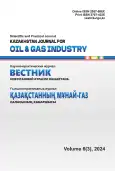Automated methodology for calculating key production indicators of oil field development for business planning model
- Autores: Zholdybayeva A.T.1, Ibrayev A.Y.1
-
Afiliações:
- Satbayev University
- Edição: Volume 6, Nº 3 (2024)
- Páginas: 72-81
- Seção: Oil and gas field development and exploitation
- URL: https://journal-vniispk.ru/2707-4226/article/view/266874
- DOI: https://doi.org/10.54859/kjogi108771
- ID: 266874
Citar
Texto integral
Resumo
Background: In order to secure the stable and efficient operations of oil-producing companies, it is essential to forecast the profitability and ROI of the enterprise, as well as to regulate development for the next 5 years. Accurate forecasts facilitate more informed planning and decision-making, directly influencing the economic sustainability and competitiveness of the enterprise.
Aim: The purpose of this study is to develop an innovative approach to automate the methodology for calculating key development indicators in a business planning model.
Materials and methods: The study utilizes methods for collecting and analyzing production and geological data, empirical forecasting models, and statistical analysis techniques to enchance the accuracy and reliability of forecasts. This approach employs modern algorithms and technologies to process large volumes of data, which allows for more accurate and reasonable forecasts of key production indicators of the field development.
Results: This methodology can be applied to forecast a five-year business plan and evaluate its expected implementation. It is integrated into the ‘Production planning and monitoring’ of the ABAI information system, which allows direct data export from the database, automates the monthly monitoring of production indicators, and generate reports for further export.
Conclusion: The proposed method for automated planning of key production indicators of the development enhances the accuracy and efficiency of forecasting, thereby improving the quality of planning and evaluating the implementation of the business plan. This contributes to more informed and strategically validated management of oil production processes. Automation of planning processes reduces the labor costs traditionally associated with manual analysis and calculations, freeing up resources for more strategic purposes. This enables rapid responses to changes in production conditions and prompt adjustments of plans. As a result, managers can allocate resources more efficiently, minimize risks, and increase the overall productivity of oil production operations.
Palavras-chave
Texto integral
##article.viewOnOriginalSite##Sobre autores
Assel Zholdybayeva
Satbayev University
Autor responsável pela correspondência
Email: assel.zholdybayeva@stud.satbayev.university
ORCID ID: 0000-0002-1015-0593
Cazaquistão, Almaty
Aktan Ibrayev
Satbayev University
Email: ak.ibrayev@kmge.kz
ORCID ID: 0009-0005-1731-7092
Cazaquistão, Almaty
Bibliografia
- Makinde FA, Orodu OD, Ladipo AO, Anawe PAL. Cumulative Production Forecast of An Oil Well Using Simplified “Hyperbolic-Exponential” Decline Models. Global Journal of researches in engineering General engineering. 2012;12(2):24–38.
- Mesdour R, Almalki F, Qarni M, et al. Comparison of Analytical Model Versus Numerical Model in Estimating EUR of Well Drilled and Completed in Unconventional Source Rock. Middle East Oil, Gas and Geosciences Show; Feb 19–21, 2023; Manama, Bahrain. Available from: https://onepetro.org/SPEMEOS/proceedings-abstract/23MEOS/1-23MEOS/D011S017R002/517193.
- Arps JJ. Analysis of Decline Curves. Trans. 1945;160(1):228–247. doi: 10.2118/945228-G.
- Wolcott D. Applied Waterflood Field Development. Energy Tribune Publishing Incorporated; 2009.
Arquivos suplementares











